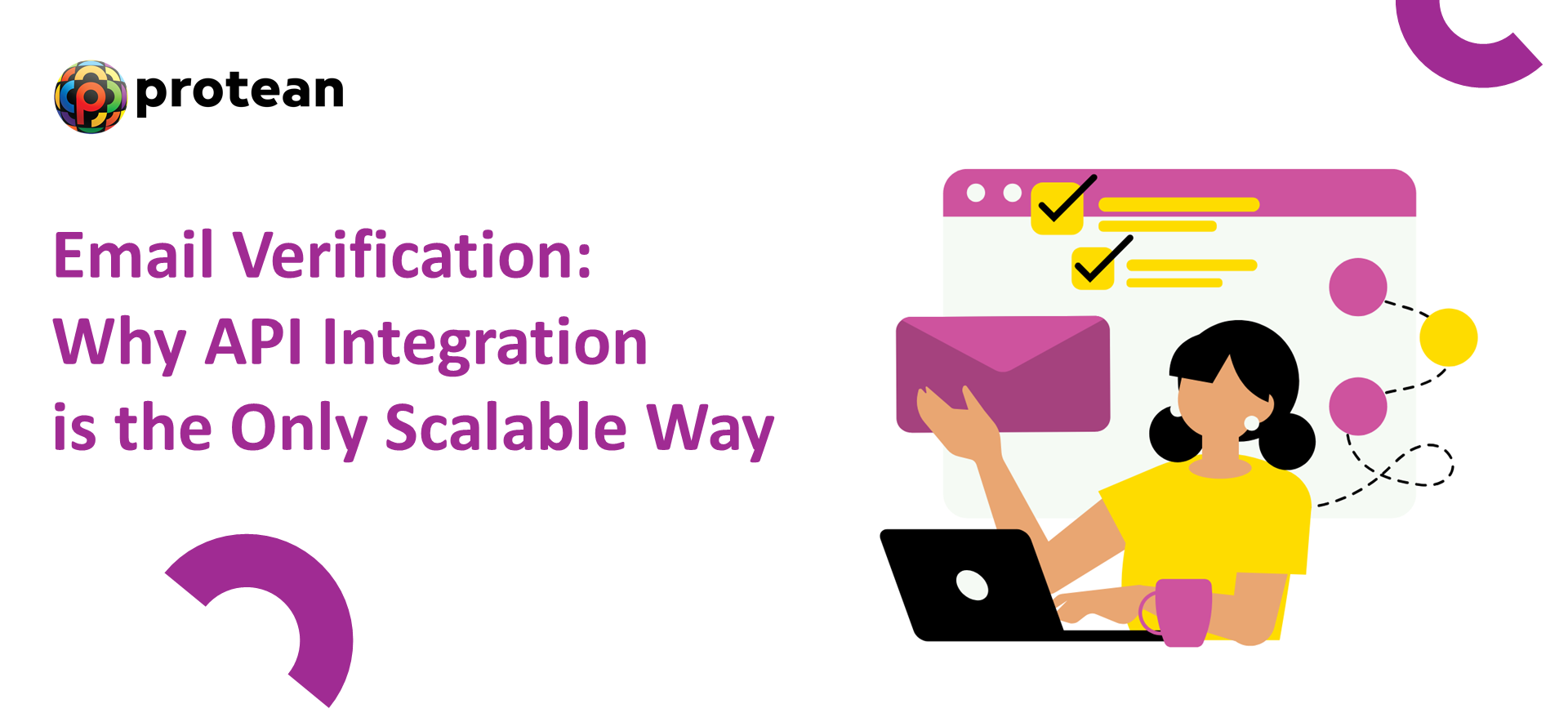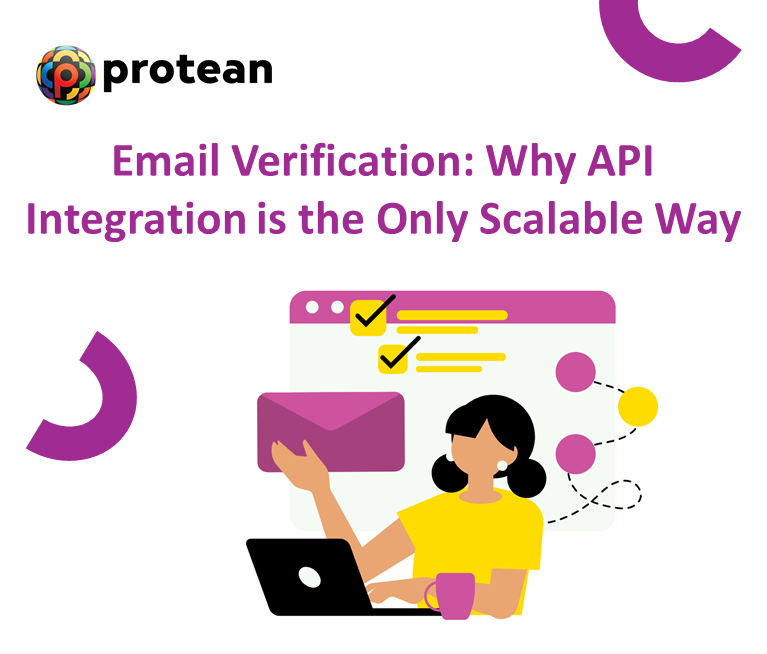In the age of digital marketing and customer relationship management (CRM), an email address is the most valuable identifier a business possesses. It is the key to communication, conversion, and retention. However, email lists degrade at an alarming rate which means that a significant portion of your marketing budget, server resources, and sales team's time is often wasted on addresses that are invalid, non-existent, or simply bot-generated spam traps.
The challenge of bulk email verification is not merely about checking a box; it's about ensuring data quality, protecting sender reputation, and maintaining compliance. For any organization processing data at scale, relying on static tools or manual processes is not just inefficient—it’s unscalable, unreliable, and ultimately unsustainable.
This is why, for bulk operations, API integration is not just an option—it is the technological imperative.
Why Traditional Methods Fail at Bulk Email Verification
It's essential to understand the sheer technological hurdles that traditional, non-integrated approaches face when dealing with large volumes of data.
1. The Bottleneck of List Uploads
Most entry-level email verification services require users to manually upload a spreadsheet (CSV or Excel) and wait for the results.
- Time Consumption: Uploading and processing massive files (e.g., millions of records) can take hours, even days. This creates a severe operational delay, especially when timely data is crucial for sales campaigns or product launches.
- Lack of Real-Time Security: The data being processed is a static snapshot. By the time the list is verified and downloaded, new emails added to the database have already begun to degrade its quality.
- Operational Friction: The process requires manual intervention at every step: upload, wait, download, import back into the CRM—a workflow prone to human error.
2. Scalability and Reliability Issues
Manual list cleaning simply does not scale with a rapidly growing business. A process that works for 10,000 records collapses under the weight of 10 million. When verification is required across multiple platforms—your CRM, marketing automation tool, and e-commerce database—a list-based approach is disjointed and unreliable. It creates data silos where verification efforts are duplicated or, worse, ignored.
3. Missing the Point of "Verification"
Effective email verification involves a complex, multi-layered check that goes far beyond a simple syntax validation. It requires:
- Syntax Check: Ensuring the email adheres to RFC standards (user@domain.com).
- Domain Validation: Checking that the domain actually exists and has valid MX records.
- SMTP Connection & Response: The critical step of simulating an email send to confirm the mailbox is live and accepting messages, without actually sending an email.
- Spam Trap and Honeypot Detection: Identifying addresses used by security organizations to catch spammers.
Performing these checks for millions of records reliably and quickly demands a robust, dedicated infrastructure—exactly what an email verification API provides.
| Also Read: Why Businesses Need Email API for Fraud Prevention and Security |
Why It’s the Most Scalable Solution
A sophisticated API integration is the most effective method to address challenges of scale, speed, accuracy, and automation in bulk email verification.
1. Automation and Seamless Workflow
An email verification API acts as a permanent, always-on connection between your internal applications (CRM, sign-up forms, marketing platform) and the verification service provider's engine.
This connection allows for two critical modes of operation:
- Real-Time Verification: As soon as a user enters an email on a sign-up form, the email API instantly verifies its validity before it even enters your database. This prevents invalid data from polluting your system from the start.
- Scheduled Bulk Processing: For existing lists, the API can be configured to run scheduled verification jobs through your CRM or data warehouse using automation scripts or task schedulers.
This automation reduces operational friction and helps ensure your data remains fresh and accurate.
| Also Read: Why API Integration of Video KYC is a Game-Changer for Policy Issuance |
2. Unmatched Speed and Scalability
The fundamental difference between a web upload tool and an email verification API is speed and capacity.
- An API often leverages high-speed cloud infrastructure designed for asynchronous processing, capable of handling very large request volumes concurrently.
- The architecture typically supports near-linear scalability, allocating more resources as list size grows to maintain consistent verification speeds.
3. Granular Data and Intelligent Classification
A high-quality email API doesn't just return 'Valid' or 'Invalid'. It provides a rich set of data points crucial for strategic decision-making:
| Classification | Meaning | Strategic Action |
|---|---|---|
| Valid | Mailbox exists and is accepting messages. | Safe to send, high priority. |
| Accept All | Domain accepts all emails, but mailbox status is uncertain. | Use with caution, high-risk segment. |
| Invalid | Mailbox does not exist (hard bounce). | Must remove immediately to protect sender reputation. |
| Spam Trap/Honeypot | Addresses designed to catch spammers. | Critical removal; immediate and severe reputation threat. |
| Role-Based | Generic email (e.g., info@, sales@). | Use a separate, targeted sales strategy. |
This granular classification, delivered instantly via the email verification API, allows marketing and sales teams to segment their lists intelligently, optimizing campaign performance and reducing costs.
4. Protecting Sender Reputation
The single most important reason for accurate email verification is maintaining sender reputation—the score assigned by mailbox providers (like Gmail, Outlook) that determines whether your email lands in the inbox or the spam folder.
Every hard bounce (an invalid email) damages your sender reputation. When you're sending in bulk, a high hard bounce rate can get your entire sending domain or IP address block listed.
You significantly reduce the risk of invalid emails reaching your sending server by implementing an API integration both at entry and during routine list cleaning. This proactive data hygiene is one of the most effective ways to safeguard your long-term deliverability and the financial health of your email program.
| Also Read: How API Integration Enables Streamlined Background Verification |
Implementing the Email Verification API: A Step-by-Step Guide
The process of implementing an email verification API typically involves collaboration between a business's technical team (developers) and the marketing/data team.
Step 1: Choosing a Provider and Obtaining Credentials
Select a reliable email verification provider known for high accuracy and low latency. The provider will issue you a unique API Key—this is the secure token that authenticates your application to their service.
Step 2: Integrating the Real-Time Check (Point of Entry)
This involves embedding a small snippet of code into your sign-up or registration forms. When a user clicks "Submit," the data is passed to the email API endpoint.
- Request: Your form sends the entered email address to the API.
- Verification: The API performs its multi-layered checks (syntax, domain, SMTP).
- Response: The API sends back an instant JSON response (e.g., {"status": "valid", "reason": "none"}).
If the status is anything other than "valid," your website can display an error message, prompting the user to correct the address, effectively eliminating bad data at the source.
Step 3: Integrating the Bulk Processing Endpoint
For existing lists, the API integration utilizes a separate bulk endpoint. Instead of uploading a file, you write a script that iterates through your database records and passes them to the API in large batches, or you leverage a pre-built connector within your CRM/data tool.
Step 4: Configuring Data Handling and Workflow
The final, crucial step is configuring your internal systems to act on the API's response. For a true bulk email verification solution, this means automatically tagging, segmenting, or suppressing contacts based on the API's classification:
- Invalid/Spam Trap: Automatically mark as suppressed and remove from all sending lists.
- Valid: Mark as verified and route to the primary contact lists.
- Accept All/Role-Based: Route to a specific "high-risk" or "sales-only" list.
Conclusion: The Only Scalable Path is API-Driven
In the realm of large-scale data management, scalability is the currency of success. For any modern business that relies on email—which is to say, virtually every business—the need for fast, accurate, and continuous bulk email verification cannot be overstated.
The email verification API transforms a recurring manual chore into a fully automated, strategic safeguard, ensuring superior deliverability, cost efficiency, and a robust sender reputation. To manage data at scale, you need a system that operates at scale—and that system is an API.
Frequently Asked Questions (FAQs)
1. What is API integration in the context of email verification?
API integration connects your internal software (like your CRM, website, or marketing platform) directly to an email verification service. This allows for automated, real-time data cleansing without the need for manual file uploads or downloads.
2. Why is API integration necessary for bulk email verification?
It is one of the most scalable methods commonly used. It allows you to process millions of emails concurrently and continuously, ensuring your database is always up-to-date and preventing invalid emails from damaging your sender reputation.
3. What is an Email Verification API?
An Email Verification API is a set of protocols and tools that allows one software application to communicate with a dedicated verification service. It sends an email address to the service and instantly receives a data-rich response indicating its validity, domain status, and risk level.
4. Does the Email API actually send an email to check validity?
No. A proper email verification API simulates the process. It establishes an SMTP connection with the recipient's mail server and requests status information without delivering a message. This confirms the mailbox's existence without notifying the recipient or marking it as a hard bounce.
5. Can I use the Email Verification API for both real-time sign-ups and existing lists?
Yes. The power of API integration is its versatility. It can be implemented to verify sign-ups instantly at the point of entry and also used for large, scheduled bulk email verification runs on your entire existing database.

